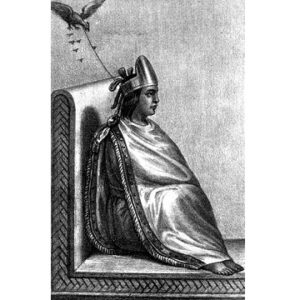Cuauhtemoc was the last Aztec Emperor, reigning between 1520 and 1521. He was the cousin of Emperor Moctezuma II and was born to Ahuitzotl and Tlilancapatl. Cuauhtemoc’s ferocity and drive were well-known from an early age; his name signifies “a person who has descended like an eagle.” Cuauhtemoc was strong-minded and unwavering, like a descending eagle that is focused and acute. In 1520, he replaced Cuitláhuac after the latter died of smallpox at a young age. Cuauhtemoc was only 25 years old at the time he ascended the throne. Only a few Aztec captains were qualified for the position. Cuauhtemoc was chosen by the upper noblemen as the most capable candidate, which led to his appointment. Cuauhtémoc defended the city during a four-month siege during his reign as Emperor. Cuauhtemoc was later arrested by the Spanish, who tortured him in order to get information about Aztec treasure. Cuauhtemoc’s tenacity was legendary, as he maintained his silence under severe torture and refused to reveal the location of traditional Aztec wealth until the very end. Cuauhtemoc’s future insurgency was feared, so Hernan Cortes, a Spanish conquest, assassinated him.
Childhood and Adolescence
Cuauhtemoc was born in 1495 to Ahuitzotl, the Aztec emperor, and Tlilancapatli, his wife. He was the Emperor’s eldest legitimate son.
To complete his official education, Cuauhtemoc went to Calmecac, a school for upper-class males.
He enlisted in the military after completing his education. Cuauhtlatoani, or eagle ruler, was given to him because of his tenacity, resolve, and ferocity. He was aggressive towards his foes, just as an eagle at its most ferocious when catching its prey.
Reign & Accession
He was named ruler of Tlatelolco in 1515. This post was only open to exceptional males and warriors who had a history of capturing and sacrificing adversaries.
Cuauhtémoc was elected Emperor by the country’s top noblemen in 1520, following the death of Montezuma’s successor, Cuitláhuac, from smallpox.
Cuauhtemoc ascended the throne as Hernán Cortés marched on Tenochtitlán, the Aztec capital, with the help of formidable Indian allies. Cuitlahuac’s predecessor, Cuitlahuac, had developed a defense program against invaders, particularly Spanish allies, that left the country isolated and resulted in the desertion of several polities that had previously been under Tenochtitlan’s control.
In 1521, Cuauhtémoc’s border warriors were forced to flee. He defended his city by going to war with the Spaniards. The city was harmed by damage during his four-month siege, with fewer Indians surviving. Only the area of Tlatelolcas, where women also took part in the conflict, remained faithful to the Emperor.
Cuauhtemoc was kidnapped by the Spanish on August 13, 1521, while attempting to depart Tenochtitlan by crossing Lake Texcoco. Cuauhtemoc was initially regarded with respect by Cortes. When the amount of money found was insufficient, he tortured Cuauhtemoc to expose the location of the Aztec treasure. Cuauhtemoc, on the other hand, kept the information to himself.
Despite being in the hands of the Spaniards, Cuauhtemoc kept his title of Emperor, despite not being a sovereign monarch. After the collapse of Mexico City, he took up residence in Tecpan, a two-story stone castle near Tlatelolco built in true Renaissance style.
Fearing insurgency from Cuauhtemoc, Cortes led Cuauhtemoc and several other nobles to Honduras on an expedition. Cortes ordered Cuauhtemoc to be hung on the journey for allegedly conspiring against Cortes and other Spaniards.
Major Projects of Cuauhtémoc
Cuauhtemoc was recognized for his ferocity and resolve during his rule. Cuauhtemoc, as strong-willed as he was, defended the city during the four-month siege. Despite being kidnapped and tortured by the Spaniards for exposing the Aztec wealth’s location, he stayed steadfast and did not reveal it until the end.
Personal History and Legacy
Cuauhtemoc married Isabel Moctezuma, Emperor Moctezuma II’s daughter. The exact number of children they had is unknown.
Cuauhtemoc’s capture by Cortes put an end to the Aztecs’ resistance. By 1525, he had joined Cortés’ army as an auxillary soldier, advancing into Honduras with the Spaniard’s army.
Cortes was brainwashed into believing that Cuahtemoc was a traitor who was scheming against him during the perilous journey to Honduras. He opened a treason trial for the Aztec leader, enraged. Cuauhtemoc was convicted and sentenced to death by hanging after being proven guilty.
Following Cuauhtemoc’s death, the plot takes on new twists and turns. While some claim Mexicalcingo, a Tenochtitlan resident, said Coanacoch (ruler of Texcoco), Tetlepanquetzal (ruler of Tlacopan), and Cuauhtemoc were arranging Cortes’ killing, others say Tapia and Juan Velásquez disclosed the scheme.
On February 28, 1525, Cuauhtemoc was hung. He chastised Cortes for breaking his pledge and executing him unfairly in his final statement.
Surprisingly, Cuauhtemoc’s final speech had such an impact on Cortes that he suffered from insomnia as a result of remorse and was gravely hurt when wandering at night.
Tlacotzin, Cuauhtemoc’s counselor, was named his successor after Cuauhtemoc’s death. But, like his predecessors, he did not live long enough and died the following year.
Estimated Net Worth
The estimated net worth of Cuauhtémoc is unknown.


